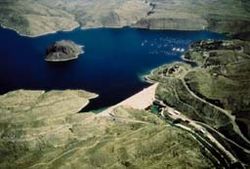Elephant Butte Reservoir
| Elephant Butte Reservoir | |
|---|---|

Elephant Butte Reservoir and Dam
|
|
| Location | Sierra County, New Mexico |
| Coordinates | 33°09′14″N 107°11′32″W / 33.153969°N 107.192113°WCoordinates: 33°09′14″N 107°11′32″W / 33.153969°N 107.192113°W |
| Lake type | Hydroelectric reservoir |
| Primary inflows | Rio Grande |
| Primary outflows | Rio Grande |
| Basin countries | United States |
| Surface area | 36,500 acres (14,800 ha) |
| Water volume | 2,065,010 acre·ft (2.54715 km3) |
| Surface elevation | 4,414 ft (1,345 m) |
Elephant Butte Reservoir is a reservoir on the Rio Grande in the U.S. state of New Mexico, 5 miles (8.0 km) north of Truth or Consequences. This reservoir is the 84th largest man-made lake in the United States and the largest in New Mexico by total surface area. It is the only place in New Mexico where one can find pelicans perched on or alongside the lake. There are also temporary US Coast Guard bases stationed at Elephant Butte. It is impounded by Elephant Butte Dam and is the largest reservoir in New Mexico by peak volume. The reservoir is also part of the largest state park in New Mexico, Elephant Butte Lake State Park.
The reservoir is part of the Rio Grande Project, a project to provide power and irrigation to south-central New Mexico and west Texas. It was filled starting between 1915 and 1916.
The reservoir can hold 2,065,010 acre feet (2.54715×109 m3) of water from a drainage of 28,900 square miles (74,850 km²). It provides irrigation to 178,000 acres (720 km²) of land.
The name "Elephant Butte" refers to a volcanic core similar to Devils Tower in Wyoming. It is now an island in the lake. The butte was said to have the shape of an elephant lying on its side.
Fishing is a popular recreational activity on the reservoir, which contains striped bass, white bass, largemouth bass, crappie, walleye and catfish.
Elephant Butte Dam, constructed between 1911 and 1916, with the reservoir fill started in 1915, was a major engineering feat in its day. The enormous concrete dam is the major feature of the Elephant Butte National Register Historic District. New Mexico State Parks operates a visitor center that contains information on the construction of the dam. At the time of its construction, the dam was the largest irrigation dam ever built with the exception of the Aswan Dam in Egypt.
...
Wikipedia
